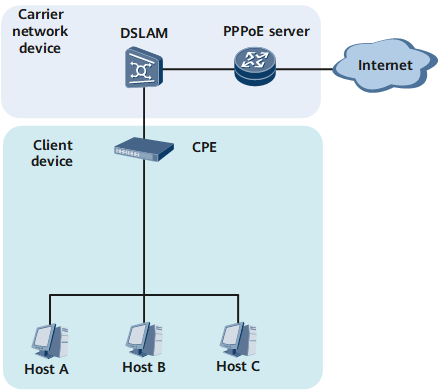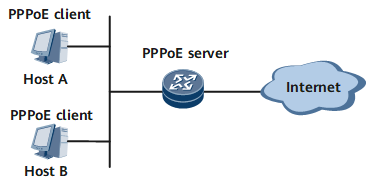Overview of PPPoE Access
Point-to-Point Protocol over Ethernet (PPPoE) is a link layer protocol that transmits PPP datagrams through PPP sessions established over point-to-point connections on Ethernet networks.
As a supplementary protocol of PPP, PPPoE provides access services for hosts on Ethernet networks, and implements user control and accounting.
PPPoE uses the client/server model. A PPPoE client initiates a connection request to a PPPoE server. After a session is established, the PPPoE server provides access control and authentication for the PPPoE client. The PPPoE user login process involves two stages: PPPoE negotiation and PPP negotiation. PPP negotiation includes Link Control Protocol (LCP) negotiation, Password Authentication Protocol (PAP)/Challenge Handshake Authentication Protocol (CHAP) authentication, and Network Control Protocol (NCP) negotiation.
A PPPoE session can be established either between devices or between a host and a device.
- When a PPPoE session is established between devices, all hosts transmit data over the same PPP session, without the need to install PPPoE client dialup software. Generally, all users in an enterprise share an account. Figure 1 shows the networking of this mode. The CPE is a PPPoE client and located within an enterprise, and a carrier network device is the PPPoE server.
- When a PPPoE session is established between a host and a device, the session is needed for each host. Each host is a PPPoE client, and a carrier network device is the PPPoE server. Figure 2 shows the networking of this mode. Each host has an account for access control and accounting. Each host must have PPPoE client dialup software installed to function as a PPPoE client. This networking applies to campuses and residential areas.
PPPoE access has the following advantages:
-
PPP data packets are transmitted over Ethernet. In addition to Internet Protocol, PPP data packets can have other types of protocols encapsulated, even link layer protocols, such as Ethernet.
-
PPPoE access provides rich accounting data, such as the numbers of incoming and outgoing packets and bytes, and start and end time of connections.
-
PPPoE access supports assignment of both IPv4 and IPv6 addresses.

Services are interrupted if the memory size of the master main control board is different from that of the slave main control board.

